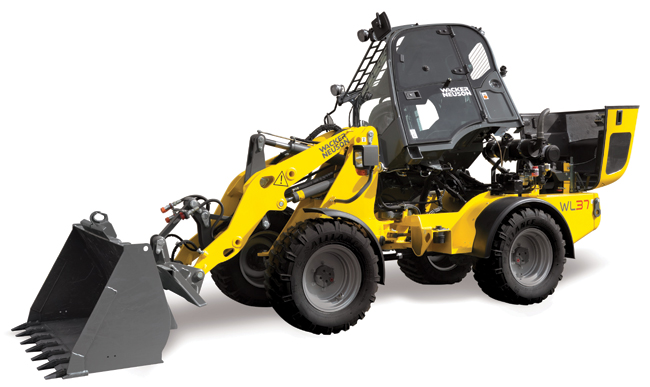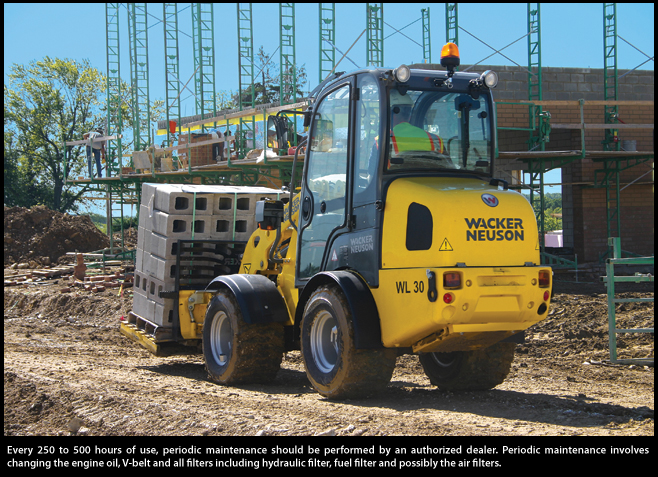The First 50 Hours Forward
When a contractor invests in equipment costing tens of thousands of dollars, preventative maintenance is the No. 1 tool to keep it running properly and efficiently, extending the life above 10 years and 10,000 hours, ultimately saving the owner money. Throughout the lifetime of a compact wheel loader, many common issues can be avoided with the proper care of daily, periodic, annual and seasonal maintenance. It can be tempting to skip or not completely fulfill these maintenance tasks in order to save a few minutes keeping a project on schedule. However, if proper maintenance is not applied, the outcome can be untimely and expensive.

Maintenance Matters for Maximum Efficiency
Being proactive with maintenance gives the contractor additional benefits such as reduced downtime and extended overall life of the machine. Following the manufacturer’s recommendations is the best practice, but often overlooked. Review the manufacturer’s maintenance manual and perform the maintenance tasks according to the schedule.
The initial inspection tasks should have been performed by an authorized dealer. As stated in Wacker Neuson’s Wheel Loader Maintenance Manual, “To ensure proper functioning of the machine, it is required that the first inspection be performed after 50 hours, or at the latest, three months after initial startup.” This is to assure that the machine “breaks in” properly.
After the first 50 hours of the wheel loader’s use, the maintenance schedule is grouped by the amount of time on the machine: daily checks and maintenance points, periodic maintenance and annual/seasonal maintenance. Daily maintenance should ideally be performed at the beginning of the shift by the operator.
Many manufacturers design machines to make daily maintenance steps as easy as possible — like easy access to the engine through a large engine housing, tiltable cab or high underbody clearance, making maintenance and repairs efficient and easy. The daily maintenance tasks include checking fluid levels such as fuel, engine oil, engine coolant and hydraulic oil. Applying grease to proper areas is important to do correctly and the operator should refer to the operator’s maintenance manual for correct process and locations.
The operator should also do a visual inspection of the wheel loader checking for loose linkage pins and any type of leakage that might occur. In dusty environments it is important to clean the air filter and cooler to ensure top performance from the engine by having full access to clean air and avoid getting clogs and dirt inside. One procedure that is often overlooked is checking the tire pressure. Properly inflated tires contribute to the stability and load handling capabilities of the machine. When overlooked, it could create a hazard or make the machine prone to roll-over. If all the tasks are done properly, according to Tom Peterson, product development technical specialist for Wacker Neuson Corp., daily maintenance should take about 10 to 15 minutes for the operator to complete.
Every 250 to 500 hours of use, periodic maintenance should be performed by an authorized dealer. Periodic maintenance involves changing the engine oil, V-belt and all filters including hydraulic filter, fuel filter and possibly the air filters. Periodic maintenance intervals also include checking the fluid levels of the axles and planetary drive systems, as well as filling the AC system. Visual inspection of hoses, steering components, such as the axle to chassis, lug nuts and all fastening hardware are required during the periodic maintenance. Also check the fuse block and battery, inspecting its condition and voltage. Be sure the battery connections are secure.
Annual maintenance involves adjusting the engine valves, changing the hydraulic fluid and replacing the tank vent which is often overlooked. According to Peterson, “The tank vent controls pressure inside the hydraulic tank. Failure can cause a tank to go into negative pressure, causing cavitation in pumps. The tank vent is also responsible to reduce condensation inside the hydraulic tank reducing moisture in the oil resulting in long term savings.”
Maintenance in the Extremes
Extreme weather conditions, either hot or cold, can affect wheel loader maintenance schedules and adjustments should be made accordingly. In extreme cold weather situations, it is important to check the antifreeze and washer fluid more often than on the printed schedule to be sure that it is full and not frozen.
Also during cold conditions, the use of an engine pre-heater system can be helpful for top-quality performance. The preheating system warms the engine fluids and hydraulic tanks before starting to ensure proper and smooth flow through the machine. Adjustments also need to be made for the fluids in extreme operation conditions. For example, in cold weather, thinner grade oil may be required to properly lubricate engine and hydraulic systems. In extremely hot weather, conditions call for thicker oil. Lastly, temperature changes can be harmful to the batteries and should be checked periodically.
Anytime wheel loaders are used for applications such as deicing salts in cold climates or for hauling or spreading fertilizer, the loader is subject to a highly corrosive atmosphere. Under these conditions, preventing rust should be a top priority. Salt and fertilizer can eat away at metal parts of the wheel loader, causing premature corrosion. Rubber components like hoses and tires will experience a more rapid pace of deterioration. Application of an aggressive media protection, like a spray-on corrosion inhibitor, should be applied to all main metal components that are susceptible to rust. Peterson adds, “Aside from applying an aggressive media protection, one of the best and easiest ways to protect your asset is to wash the wheel loader every day when used in these applications.”
Tips for Attachments
Attachments are often rented and the operator may not know if the proper maintenance was done before rental. Hydraulic driven and operated attachments can potentially be harmful because of contamination. Peterson addresses issues with rented attachments, “If renting is ideal, be sure that all components are clean,” he says. “There could be contamination from the attachment to the machine from water, dirt and metal within the oil.” However, if rental can be avoided, purchase your own.

Attachments are different than the machines because wheel loaders have hour meters that help determine when to perform periodic maintenance. However, attachments do not. Commonly used attachments, especially hydraulic powered attachments, should have maintenance performed as required in their manuals.
Saving Cash
Whenever performing maintenance, be sure that the operator’s manual is a close and ready-to-use reference. If not, problems may occur and excess money will be spent. Similar to any piece of compact equipment, the most costly fix on a compact wheel loader is the engine and the drivetrain components. The most common mistake is not inspecting the linkage pins, changing the engine oil, checking tire pressure and replacing the tank vent, all of which can have a costly snowball effect to damages, repairs and parts. Daily maintenance and service by authorized dealers help avoid costly repairs. Also consider an extended warranty for the whole machine or just the powertrain.
To optimize the life of a wheel loader to its full performance potential: “First is maintenance,” advises Peterson. “Be sure to always keep up with maintenance and get any repairs done in a timely fashion. The wheel loader should also be kept clean. Contractors should be sure that all operators are properly trained with running the machinery and how to perform all daily inspections properly.”
By taking a few minutes to follow the proper maintenance schedule, the resulting benefits include more efficiency, money savings and a wheel loader lifetime that could be up to a decade.
Marcus Auerbach is the director of compact equipment at Wacker Neuson Corp., based in Menomonee Falls, Wis.
